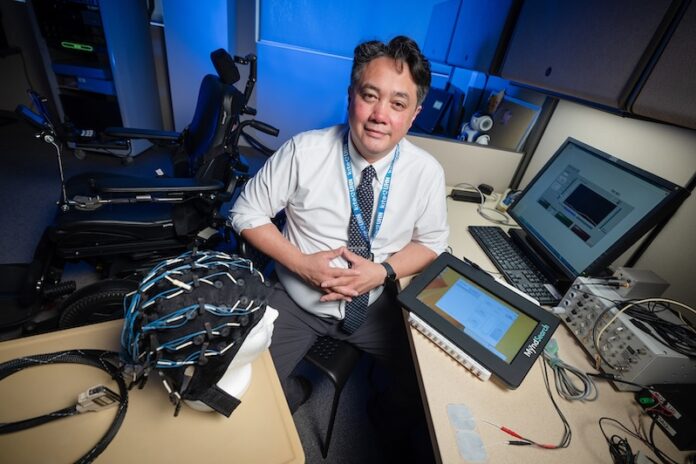Dr. Cesar Marquez-Chin has been preparing for the future ever since he watched Star Wars for the first time.
Growing up in Mexico City, the University Health Network (UHN) scientist spent countless hours at the local movie theatre, watching and rewatching his favourite science fiction movies play out on the silver screen, where his young mind opened up to infinite possibilities.
“For me, science fiction is like going to school,” Dr. Marquez-Chin says. “I know that sounds ridiculous, but when I see things on the screen, I get a lot of inspiration. It makes me wonder, ‘How would I do this? Is this even possible?’ I love movies; they transport me to a different planet. I think I watched Star Wars seven times when it came out.”
His emerging enthusiasm for technology would soon be tempered by tragedy. On the morning of September 19, 1985, a powerful 8.1-magnitude earthquake rocked the Mexico City area, killing more than 10,000 people and injuring 30,000 others.
“It was an awful situation,” Dr. Marquez-Chin says. “As you can imagine, after that event, the number of people with disabilities on the street grew exponentially. I think that planted a seed of interest in the field of rehabilitation engineering.”
Mind over matter
Now, Dr. Marquez-Chin is part of the Neural Engineering and Therapeutics (NET) Team at the KITE Research Institute, where he’s developing the kind of futuristic technology he might have seen at the movies back in Mexico. Even better, his work combines his love of sci-fi with his interest in rehab.
His current research aims to restore a person’s ability to move voluntarily after suffering from one of the two main causes of paralysis: stroke or spinal cord injury. The technology works by retraining the brain to make the body move again without the ongoing aid of assistive devices, such as a wheelchair. It relies on a brain-computer interface that identifies when the body is trying to move and electrical stimulation to help the nervous system make it happen.
Dr. Marquez-Chin’s work couldn’t come at a better time. According to a study by the Heart and Stroke Foundation, there are 108,707 stroke occurrences in Canada every year (or one every five minutes), all with the potential to cause some degree of paralysis. There are also more than 85,000 Canadians currently living with a spinal cord injury and around 4,500 new cases every year.
“When we treat someone, we ask them to attempt a movement with the affected limb or limbs depending on the condition,” he explains. “The brain-computer interface detects the intention to move by analyzing brain activity in real time. When it identifies that the person is attempting movement, it triggers functional electrical stimulation that actually helps the person produce the movement.”
Ultimately, the goal is to help patients live as independently as possible by restoring their own ability to move.
Life imitates art
It’s not lost on Dr. Marquez-Chin that his research often mirrors the science fiction films he enjoyed all those years ago. Some of the technology, he says, isn’t as far-fetched as one might think.
The Matrix, for example, takes the concept of the brain-machine interface to the next level by fully immersing humanity in a virtual world created by machines. The interface that enables this illusion not only extracts massive amounts of information from Neo – or anyone else connected to the Matrix – it also injects information directly into their brains to allow them to touch and control their environment.
“That’s really interesting because some of those technologies are actually in development,” Dr. Marquez-Chin says. “Not at that level, but a cochlear implant, for example, uses a microphone that basically translates sound into pulses that stimulate your brain so you can hear. We also have visual prostheses in which people who are blind can see colours or broad figures. So, it’s really tricky, but maybe one day.”
Back to the future
Another work of fiction that may be flirting with reality is Blade Runner, a movie set in a dystopian future riddled with synthetic humans. “Blade Runner is very unique in the sense that it’s all biological,” Marquez-Chin says. “They’re basically clones that are given an expiry date. But what’s interesting is the notion of implanting memories.”
While he doesn’t think we’ll see evil replicants running around any time soon, Dr. Marquez-Chin says there are researchers at UHN who are trying to understand how memories are created at the neuronal level. “This is very important because it will allow us to potentially create new interventions for people with memory problems, such as people with Alzheimer’s disease. Whether it’s a form of prevention or treatment, that’s another thing. We’re not quite there yet in terms of implanting memories.”
As for his own real-life sci-fi exploits at KITE, the results have been encouraging and Dr. Marquez-Chin’s team has witnessed important changes in people who have not traditionally responded well to therapy. The closest parallel to his work is probably found in that galaxy far, far away.
In the Star Wars movies, Luke Skywalker requires a robotic hand replacement after an unsettling encounter with Darth Vader’s lightsaber. “That notion of using signals from the nervous system to control an external device aligns with what we’re trying to do,” he says. “It’s funny to think that when I was little, maybe I was already working on this.”
By Dave Yasvinski
Dave Yasvinski works in communications at Unity Health.


